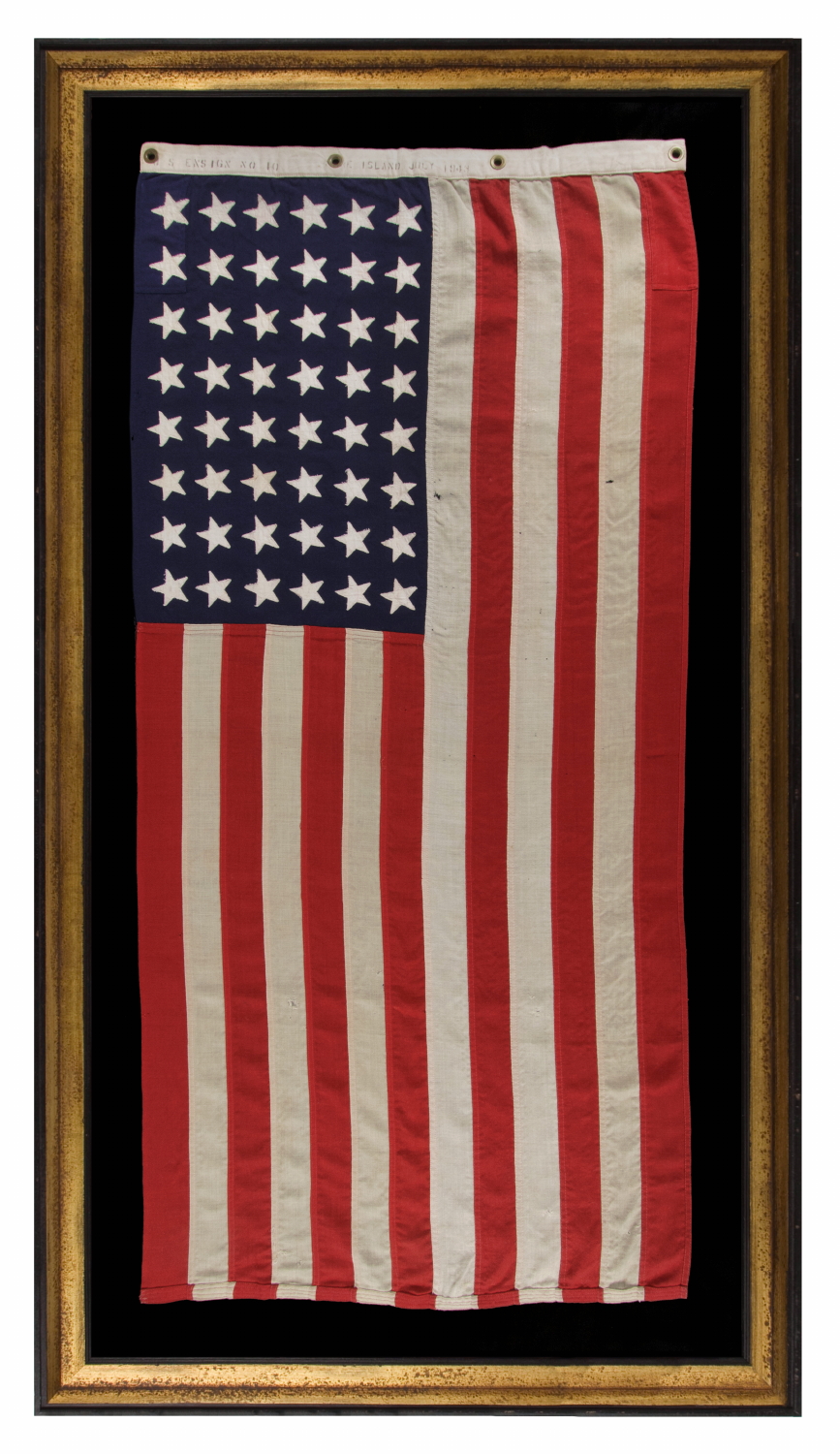
| |
48 STAR, U.S. NAVY SMALL BOAT ENSIGN WITH AN ATTRACTIVE, ELONGATED FORMAT, MADE AT MARE ISLAND, CALIFORNIA DURING WWII, SIGNED AND DATED JULY, 1943 |
|
| Available: |
Sold |
| Frame Size (H x L): |
Approx. 43.5" x 77.5" |
| Flag Size (H x L): |
32.5" x 66.5" |
|
| Description....: |
|
48 STAR, U.S. NAVY SMALL BOAT ENSIGN WITH AN ATTRACTIVE, ELONGATED FORMAT, MADE AT MARE ISLAND, CALIFORNIA DURING WWII, SIGNED AND DATED JULY, 1943:
48 star American national flag, made during World War II (U.S. involvement 1941-45) and signed along the reverse side of the hoist with a black stencil that reads: "U S ENSIGN NO 10 MARE ISLAND JULY 1943". Located on the western edge of the City of Vallejo, about 23 miles northeast of San Francisco, Mare Island (actually a peninsula) served as a principal seat of U.S. Navy defense, beginning in the mid-19th century. The site was originally chosen following an expedition that set forth in 1850, when Commodore John Drake Sloat was ordered to lead a survey party in quest of a logical site for the nation's first Pacific naval installation. Sloat recommended the island across the Napa River from the settlement of Vallejo; it being "free from ocean gales and from floods and freshets." On November 6th of that year, two months after California was admitted to statehood, President Fillmore reserved Mare Island for government use. The U.S. Navy Department acted favorably on Commodore Sloat's recommendations and Mare Island was purchased in July, 1852, for the sum of $83,410 for the use as a naval shipyard. Two years later, on September 16th of 1854, Mare Island became the first permanent U.S. naval installation on the West Coast, with Commodore David G. Farragut serving as Mare Island's first base commander.
The base became home to what was known as the Pacific Fleet, and remained so until the threat of Japanese expansionism caused the shift to a more advanced position at Pearl Harbor. It was very active in WWII, Korea, and Vietnam, but would eventually close in 1993 after Congress approved the findings of the Base Realignment and Closure Report.
Measuring approx. 32.5" on the hoist and 66.5" on the fly, the proportions of the flag are noticeably elongated. This gives it an unusual presentation that is especially attractive. Long and narrow proportions were well-suited to maritime use. Flags wore out quickly at sea, where there was little-to-no protection from the wind, and having extra length allowed the flag to be turned back and hemmed several times before it was retired from use.
The 48 star flag became official in 1912 following the addition of New Mexico and Arizona. 48 remained the official star count throughout WWI (U.S. involvement 1917-18), WWII, and the Korean War (1950-53), until Alaska gained statehood in 1959 and the 49th star was added.
Construction: The canton and stripes of the flag are made of wool bunting, pieced with machine stitching. The stars are made of cotton and are double-appliquéd (applied to both sides) with a zigzag machine stitch. There is a heavy canvas binding with four especially heavy gauge brass grommets for hoisting, each stamped with a number "2". The weight of the wool and the stalwart construction is typical of what the Navy preferred for its flags in this period. The fabric is heavier grade than what was typically employed in commercially-made flags and the fly end was bound with 4 rows of stitching instead of the usual two. There are large gussets (patches of extra fabric added for support in areas that received the most wear) in the upper and lower corners on the hoist end.
Mounting: The flag has been hand-stitched to 100% silk organza for support on every seam and throughout the star field for support. It was then hand-stitched to 100% cotton twill, black in color, which was washed to reduce excess dye. An acidf-free agent was added to the wash to further set the dye and the fabric was heat-treated for the same purpose. The flag has been placed in its correct vertical format, with the canton in the upper left, in order that the stencil may be viewed on the reverse side of the hoist binding. The flag was then placed in a black-painted, hand-gilded and distressed Italian molding. The glazing is U.V. protective Plexiglas.
Condition: There is very minor mothing, but there are no further condition issues. The colors are strong and the flag presents beautifully. Many of my clients prefer early flags to show their age gracefully. |
|
|
|
| Collector Level: |
Intermediate-Level Collectors and Special Gifts |
|
| Flag Type: |
Sewn flag |
|
| Star Count: |
48 |
|
| Earliest Date of Origin: |
1943 |
|
| Latest Date of Origin: |
1943 |
|
| State/Affiliation: |
California |
|
| War Association: |
WW 2 |
|
| Price: |
SOLD |
|
| |
Views: 3175 |
|
|
|

